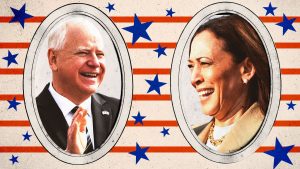Updated Aug. 6, 2024 5:44 pm ET

Vice President Kamala Harris has named Minnesota Gov. Tim Walz as her running mate. WSJ’s Ken Thomas explains what Walz brings to the Democrats’ election showdown with Donald Trump and JD Vance. Photo: Photo: Jim Vondruska/Getty Images
The vice president talked to President Biden on the phone before announcing Walz as her pick, said Emilie Simons, a White House spokeswoman. Biden also spoke to Walz and congratulated him, later praising him as a “powerful voice for working people.”
Walz wasn’t widely known outside of Minnesota before his name appeared on Harris shortlists. But he gained some Democratic fans outside his state in recent weeks for television interviews that hit at former President Donald Trump and his running mate, Ohio Sen. JD Vance, without being overly nasty. He called the pair “weird,” a word that went viral among Democrats.
Harris bypassed Pennsylvania Gov. Josh Shapiro, another finalist for the job who was viewed as a more conventional pick because he had the potential to help deliver a key battleground state. Shapiro was expected to attend the Philadelphia rally alongside Harris and Walz.
Shapiro’s selection might have also angered some progressives because he has supported private-school vouchers and is a vocal supporter of Israel at a time when some activists on the left have condemned the Biden administration’s handling of the war in Gaza. One person close to the process also said the public lobbying conducted by many of Shapiro’s allies was a frustration to Harris’s team.
Shapiro said in a statement Tuesday he was grateful for having been considered and that Walz was an “exceptionally strong addition to the ticket.”
Pat Haney, 72, a school superintendent from Philadelphia, said she is excited about Walz’s selection in part because it allows for Shapiro to remain her home state’s governor. Pointing to Walz’s military and education background, she said she thinks he “can be helpful in swing states and the Midwest.”
Sheike Ward, 33, a Philadelphia resident who works in healthcare and is a member of SEIU, said she looked into the records of all of the finalists and saw Walz as the most pro-union. She also liked his background in teaching. “Anybody that’s been a teacher is most likely going to be a caring person,” she said.

Minnesota Gov. Tim Walz speaking in July with a man whose family business was destroyed as a result of a damaged dam and related flooding. Photo: Casey Ek/The Free Press/Associated Press
A person close to the process said Walz was picked for his executive experience and record on issues that Democrats want to work on nationally, such as the child tax credit, paid leave, abortion and gun control. The person also said his background as a veteran, hunter and onetime coach would be appealing in Midwestern states, and that he is viewed as a strong messenger to counter Trump and Vance. He also has a good personal rapport with Harris.
Trump’s campaign in a statement suggested the selection represented a doubling down on progressivism. Aides to his campaign said they think Walz will be easier to define as a liberal and attach to the broader theme of Harris being out of step with many Americans, while not making it harder for Trump to win a battleground state.
“It’s no surprise that San Francisco Liberal Kamala Harris wants West Coast wannabe Tim Walz as her running-mate,” the statement said. “Walz has spent his governorship trying to reshape Minnesota in the image of the Golden State.”
Vance, who is scheduled this week to make stops in many of the places Harris and Walz plan to go, told reporters traveling on his campaign plane that he left Walz a message after the announcement.

“I just said, look, ‘Congratulations, look forward to a robust conversation. And enjoy the ride,’” he said. “Maybe he’ll call me back, maybe he won’t.”
Democrats on Capitol Hill hailed the choice. Sen. Bernie Sanders (I., Vt.) said Walz was “a great asset” for Harris. Former Speaker Nancy Pelosi (D., Calif.) said: “To characterize him as left is so unreal.…He’s right down the middle.”
Republicans attacked Walz, with Rep. Tom Emmer (R., Minn.) saying his state’s governor is an “empty suit who has worked to turn Minnesota into Harris’ home state of California.”
At 60 years old, Walz is slightly older than Harris (she turns 60 in October). He was viewed by some Minnesotans as a moderate Democrat when first elected governor in 2018. He had grown up in small-town Nebraska and enlisted in the Army National Guard at 17. He was elected to Congress from one of the state’s more conservative districts and once earned the National Rifle Association’s endorsement.
But he has governed more to the left than some initially expected. Walz supported universal free school meals for students, voting rights for the formerly incarcerated, driver’s licenses for migrants who crossed the border illegally and recreational marijuana. He signed a law that made abortion a “fundamental right.”

Minnesota Gov. Tim Walz signed a bill in 2023 to allow driver’s licenses for state residents regardless of their immigration status. Photo: Elizabeth Flores/Star Tribune/Associated Press
To win in November, Harris likely needs to do the reverse of what Walz did. She is distancing herself from some of the more progressive parts of her record—some dating from her 2020 Democratic presidential primary campaign—in a gradual move to the middle, even as Trump works to brand her a “San Francisco liberal.”
Minnesota Republicans have suggested Walz was slow to call out the National Guard to address rioting that started after the Minneapolis police murder of George Floyd in 2020.
The rioting resulted in significant damage, including a police precinct being set on fire. Walz deployed hundreds of National Guard troops three days after Floyd’s murder as looting and arson spread. City and state officials have blamed each other for the response. After-action assessments found a breakdown in communication between government officials, the Minneapolis-based Star Tribune newspaper has reported.
Walz appears as comfortable in front of voters wearing a flannel shirt and baseball cap as he is in a suit and tie, giving him a naturalness that has served him well on the campaign trail.
After graduating in 1989 with a social-science degree from Chadron State College in Nebraska, Walz spent a year teaching in China before returning to full-time status at the National Guard and then a teaching career. He eventually landed about 80 miles southwest of Minneapolis in Mankato, Minn., where he taught social studies and raised two children with his wife, Gwen Walz.
He also continued in the National Guard, where he specialized in field artillery and did a tour overseas, although he never saw combat. After 24 years in the National Guard, he rose to the rank of command sergeant major before running for Congress in 2006.

House Speaker John Boehner administering the House oath to Rep. Tim Walz during a mock swearing-in ceremony in 2011. Photo: Jacquelyn Martin/AP
In his early 40s, Walz entered politics and managed to unseat a six-term Republican congressman in a mostly rural southern Minnesota district. His humor, polished by years of trying to keep high-schoolers’ attention, has been a strength throughout his political career.
After 12 years in Congress, Walz ran for governor as someone willing to compromise with Republicans. He won by 11.4 percentage points in 2018, almost four points higher than his 2022 re-election victory.
Minnesota became something of a laboratory in 2023 for many of the Democratic Party’s policy goals, once Walz had a legislature fully controlled by Democrats. Besides establishing the goal of a carbon-free electrical grid by 2040, the state also passed paid family and medical leave, sick leave, transgender-rights protections, a tax credit aimed at low-income parents, and a $1 billion investment in affordable housing.
“If you need a reminder that elections have consequences, check out what’s happening in Minnesota,” former President Barack Obama wrote on social media last year.
Walz might have some historical trends going his way. Minnesota has already been home to two vice presidents, Hubert H. Humphrey and Walter Mondale, enough to rank in the top 10 states. Also, roughly a third of all past vice presidents have been governors, according to the Eagleton Institute of Politics at Rutgers University.
Vivian Salama, Alex Leary and Lindsay Wise contributed to this article.
Write to John McCormick at mccormick.john@wsj.com, Tarini Parti at tarini.parti@wsj.com and Catherine Lucey at catherine.lucey@wsj.com


